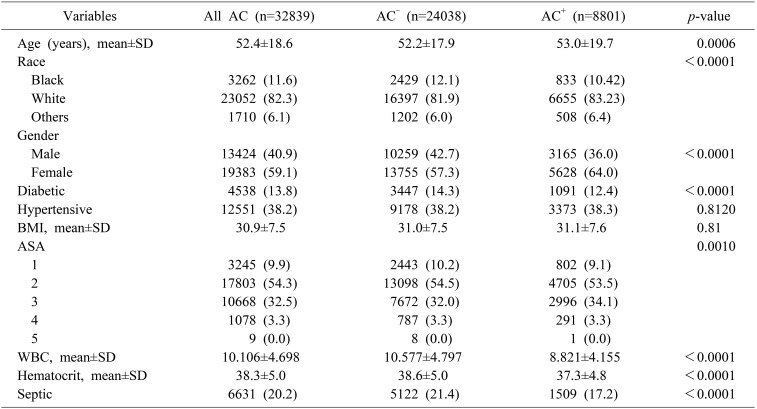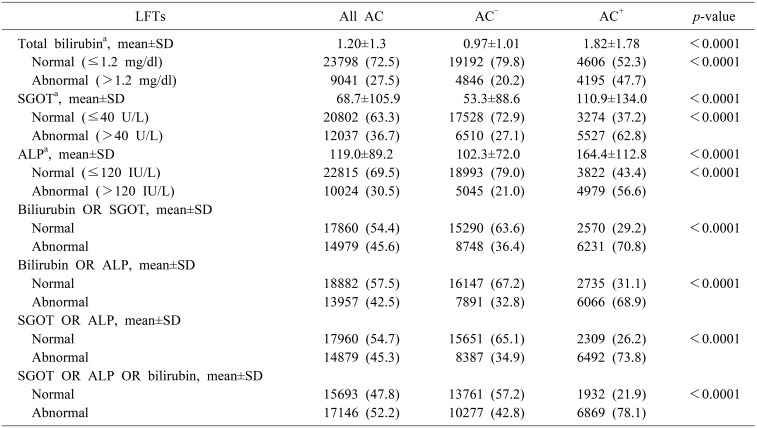1. Mitchell SA, Jacyna MR, Chadwick S. Common bile duct stones: a controversy revisited. Br J Surg. 1993; 80:759–760. PMID:
8330169.

2. Ko CW, Lee SP. Epidemiology and natural history of common bile duct stones and prediction of disease. Gastrointest Endosc. 2002; 56(6 Suppl):S165–S169. PMID:
12447261.

3. Menezes N, Marson LP, debeaux AC, Muir IM, Auld CD. Prospective analysis of a scoring system to predict choledocholithiasis. Br J Surg. 2000; 87:1176–1181. PMID:
10971424.

4. Baron RL. Common bile duct stones: reassessment of criteria for CT diagnosis. Radiology. 1987; 162:419–424. PMID:
3797655.

5. Prat F, Meduri B, Ducot B, Chiche R, Salimbeni-Bartolini R, Pelletier G. Prediction of common bile duct stones by noninvasive tests. Ann Surg. 1999; 229:362–368. PMID:
10077048.

6. Thapa PB, Maharjan DK, Suwal B, Byanjankar B, Singh DR. Serum gamma glutamyl transferase and alkaline phosphatase in acute cholecystitis. J Nepal Health Res Counc. 2010; 8:78–81. PMID:
21876567.
7. Ahn KS, Yoon YS, Han HS, Cho JY. Use of liver function tests as first-line diagnostic tools for predicting common bile duct stones in acute cholecystitis patients. World J Surg. 2016; 40:1925–1931. PMID:
27094560.

8. Padda MS, Singh S, Tang SJ, Rockey DC. Liver test patterns in patients with acute calculous cholecystitis and/or choledocholithiasis. Aliment Pharmacol Ther. 2009; 29:1011–1018. PMID:
19210291.

9. Indar AA, Beckingham IJ. Acute cholecystitis. BMJ. 2002; 325:639–643. PMID:
12242178.

10. Geraghty JM, Goldin RD. Liver changes associated with cholecystitis. J Clin Pathol. 1994; 47:457–460. PMID:
8027400.

11. Triger DR, MacIver AG, Gamlen TR, Wilken BJ. Liver abnormalities and gallstones: a prospective combined clinical, histological and surgical study. Br J Surg. 1976; 63:272–277. PMID:
1276658.

12. Trowbridge RL, Rutkowski NK, Shojania KG. Does this patient have acute cholecystitis? JAMA. 2003; 289:80–86. PMID:
12503981.

13. Videhult P, Sandblom G, Rudberg C, Rasmussen IC. Are liver function tests, pancreatitis and cholecystitis predictors of common bile duct stones? Results of a prospective, population-based, cohort study of 1171 patients undergoing cholecystectomy. HPB (Oxford). 2011; 13:519–527. PMID:
21762294.

14. Kaldor A, Akopian G, Recabaren J, Alexander M. Utility of liver function tests after laparoscopic cholecystectomy. Am Surg. 2006; 72:1238–1240. PMID:
17216828.

15. Pereira-Limâ JC, Jakobs R, Busnello JV, Benz C, Blaya C, Riemann JF. The role of serum liver enzymes in the diagnosis of choledocholithiasis. Hepatogastroenterology. 2000; 47:1522–1525. PMID:
11148992.
16. Zare M, Kargar S, Akhondi M, Mirshamsi MH. Role of liver function enzymes in diagnosis of choledocholithiasis in biliary colic patients. Acta Med Iran. 2011; 49:663–666. PMID:
22071641.
17. Parra Pérez V, Vargas Cárdenas G, Astete Benavides M, Valdivia Roldán M, Morán Tisoc L, Nuñez Calixto N, et al. [Choledocolithiasis predictors in high-risk population subjected to endoscopic retrograde pancreatocholangiography at “Hospital Nacional Arzobispo Loayza”]. Rev Gastroenterol Peru. 2007; 27:161–171. Spanish. PMID:
17712394.
18. American College of Surgeons. ACS National Surgical Quality Improvement Program. Chicago: American College of Surgeons;2011.
19. Johnston DE. Special considerations in interpreting liver function tests. Am Fam Physician. 1999; 59:2223–2230. PMID:
10221307.
20. Song SH, Kwon CI, Jin SM, Park HJ, Chung CW, Kwon SW, et al. Clinical characteristics of acute cholecystitis with elevated liver enzymes not associated with choledocholithiasis. Eur J Gastroenterol Hepatol. 2014; 26:452–457. PMID:
24518492.

21. Ahmed M. Acute cholangitis - an update. World J Gastrointest Pathophysiol. 2018; 9:1–7. PMID:
29487761.

22. Er S, Ozden S, Celik C, Yuksel BC. Can we predict severity of acute cholecystitis at admission? Pak J Med Sci. 2018; 34:1293–1296. PMID:
30344594.

23. Teefey SA, Dahiya N, Middleton WD, Bajaj S, Dahiya N, Ylagan L, et al. Acute cholecystitis: do sonographic findings and WBC count predict gangrenous changes? AJR Am J Roentgenol. 2013; 200:363–369. PMID:
23345358.

24. Habib L, Mirza MR, Ali Channa M, Wasty WH. Role of liver function tests in symptomatic cholelithiasis. J Ayub Med Coll Abbottabad. 2009; 21:117–119.
25. Fikry AA, Kassem AA, Shahin D, Shabana H. Elevated liver enzymes in patients with cholecystitis. J Surg. 2014; 2:38–41.
26. Kelly DA. Intestinal failure-associated liver disease: what do we know today? Gastroenterology. 2006; 130(2 Suppl 1):S70–S77. PMID:
16473076.

27. Thorbøll J, Vilmann P, Jacobsen B, Hassan H. Endoscopic ultrasonography in detection of cholelithiasis in patients with biliary pain and negative transabdominal ultrasonography. Scand J Gastroenterol. 2004; 39:267–269. PMID:
15074397.

28. Elta GH. Sphincter of Oddi dysfunction and bile duct microlithiasis in acute idiopathic pancreatitis. World J Gastroenterol. 2008; 14:1023–1026. PMID:
18286682.

29. Petersen BT. Sphincter of Oddi dysfunction, part 2: evidencebased review of the presentations, with “objective” pancreatic findings (types I and II) and of presumptive type III. Gastrointest Endosc. 2004; 59:670–687. PMID:
15114311.

30. Petersen BT. An evidence-based review of sphincter of Oddi dysfunction: part I, presentations with “objective” biliary findings (types I and II). Gastrointest Endosc. 2004; 59:525–534. PMID:
15044889.
31. McLoughlin MT, Mitchell RM. Sphincter of Oddi dysfunction and pancreatitis. World J Gastroenterol. 2007; 13:6333–6343. PMID:
18081221.

32. Bosma PJ. Inherited disorders of bilirubin metabolism. J Hepatol. 2003; 38:107–117. PMID:
12480568.

33. Radu P, Atsmon J. Gilbert's syndrome--clinical and pharmacological implications. Isr Med Assoc J. 2001; 3:593–598. PMID:
11519385.
34. Beltrán MA. Mirizzi syndrome: history, current knowledge and proposal of a simplified classification. World J Gastroenterol. 2012; 18:4639–4650. PMID:
23002333.

35. Tse F, Liu L, Barkun AN, Armstrong D, Moayyedi P. EUS: a meta-analysis of test performance in suspected choledocholithiasis. Gastrointest Endosc. 2008; 67:235–244. PMID:
18226685.

36. Kaltenthaler E, Vergel YB, Chilcott J, Thomas S, Blakeborough T, Walters SJ, et al. A systematic review and economic evaluation of magnetic resonance cholangiopancreatography compared with diagnostic endoscopic retrograde cholangiopancreatography. Health Technol Assess. 2004; 8:iii1–89.

37. Yokoe M, Hata J, Takada T, Strasberg SM, Asbun HJ, Wakabayashi G, et al. Tokyo Guidelines 2018: diagnostic criteria and severity grading of acute cholecystitis (with videos). J Hepatobiliary Pancreat Sci. 2018; 25:41–54. PMID:
29032636.








 PDF
PDF ePub
ePub Citation
Citation Print
Print



 XML Download
XML Download